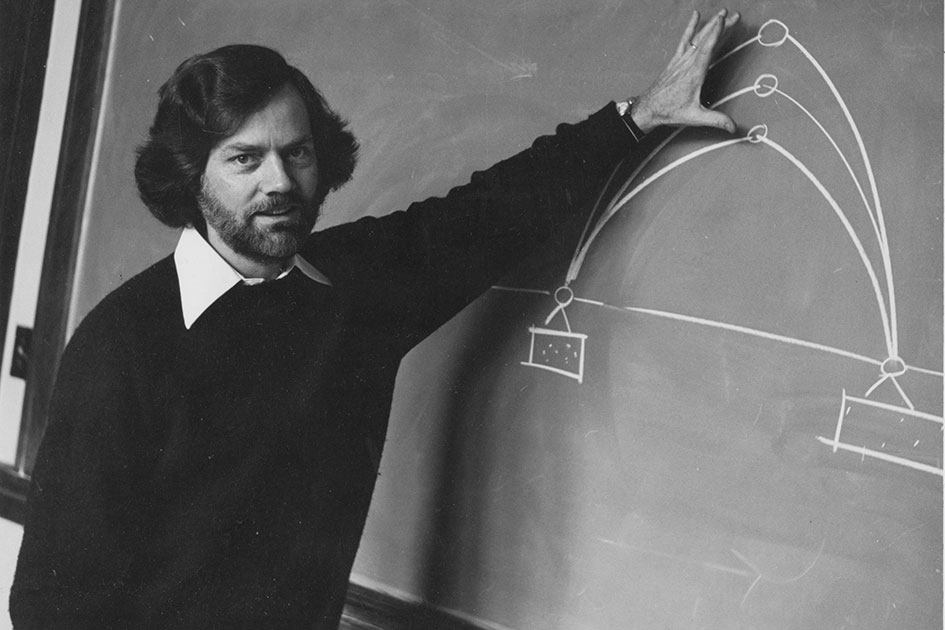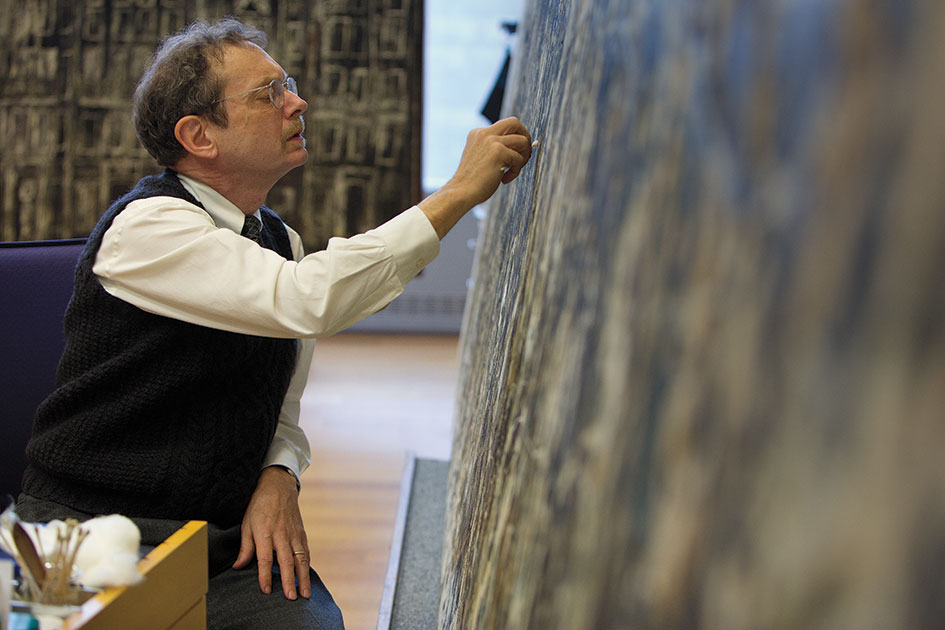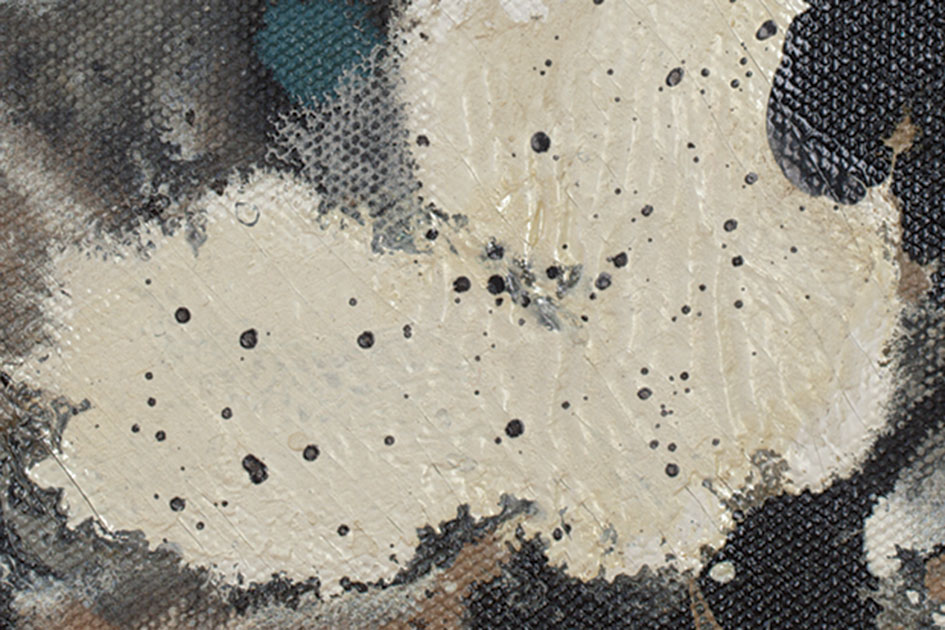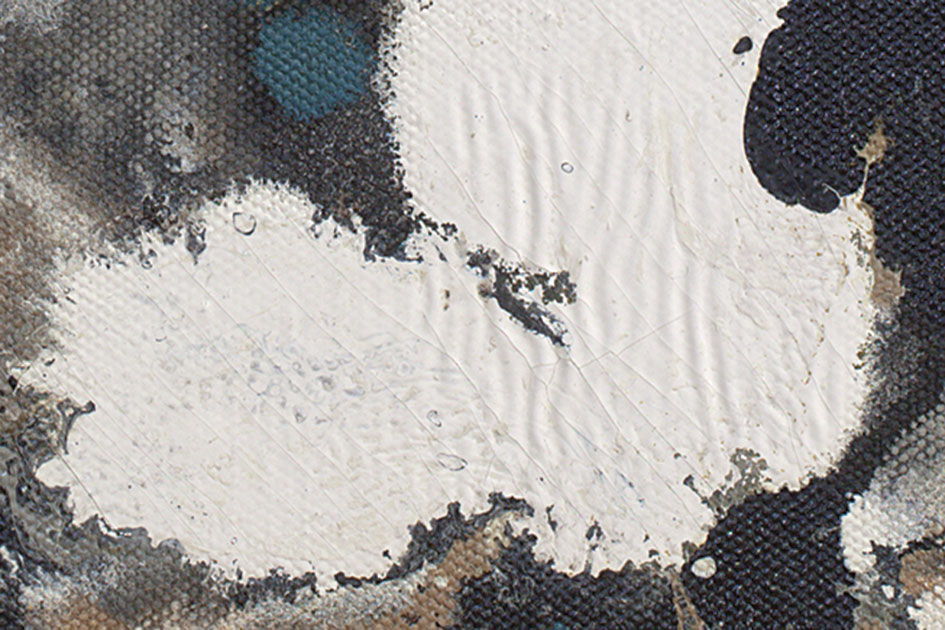The Canvas and the Clue
How Jim Coddington ’73 solved a Jackson Pollock mystery.
A painting, Jackson Pollock once said about his famously messy canvases, is “an arena in which to act.” The quintessential “action painter,” Pollock embodied America’s brawny, postwar spirit of innovation and became a household name in 1949 when images of him in his Long Island studio landed on the pages of LIFE magazine. His untimely death at the age of 44 while driving a convertible at high speeds along East Hampton’s farm lanes further stoked his biopic-ready renown. It’s no small irony, therefore, that many of Pollock’s half-century-old canvases today depend on just a few low-profile masters for their survival—namely, rare experts like Jim Coddington, the Museum of Modern Art’s chief conservator since 1996.
Art historian Max Friedlander had it right when he said: “Pity the poor restorer. If he does his job well, nobody knows. If he does his job poorly, everybody knows.” Consider the case of Cecilia Giménez. The octogenarian Spanish amateur took it upon herself to restore a century-old Ecce Homo fresco inside Zaragoza’s Sanctuary of Mercy Church in 2012, with disastrous results. Her name is now synonymous with the search words “famous botched restoration” (nearly half a million Google hits at last count), and wags have dubbed the fresco “Ecce Monkey.” No wonder conservators generally prefer anonymity. In the words of the late art historian James Beck, restoration is a lot like having a facelift: “How many times can people go through one without their poor faces looking like an orange peel?”
It was with some trepidation, then—earned through a lifetime of hard-won experience—that Coddington faced the challenge of restoring one of the signal works of postwar American art: the abstract expressionist gem One: Number 31, 1950.
An example of Pollock’s monumental drip paintings, One was completed in summer 1950 while Pollock was at the height of his powers. A virtually priceless treasure—a smaller painting, No. 5, 1948, sold for $140 million in 2006—the painting is one of Pollock’s most ambitious and monumental works. A mural-sized masterpiece in need of expert TLC (the painting measures 9 feet high by 17½ feet across), One makes a unique case for this artist’s enduring importance. In the words of the art critic Robert Hughes, Pollock in the 1940s and ’50s was “the first American artist to influence the course of world art.”
MoMA held a blockbuster Pollock retrospective in 1998 that gave One pride of place. But the exhibition also revealed that the canvas, according to Coddington, was suffering from a general “yellowing and buildup of dirt and dust in the painting’s crevices.” In July 2012, One was officially retired from the museum’s fourth floor for restoration. Over the next 10 months, Coddington and assistant conservator Jennifer Hickey embarked on a period of close examination, cleaning, and repair that they chronicled on MoMA’s blog. As they inspected the historic canvas, however, they stumbled across an unexpected puzzle—one portion of the picture contained paint and brushstrokes that were dramatically different from the rest. Was this simply an example of Pollock’s unpredictable technique? Or was it a subsequent alteration by a different hand—the equivalent of a doodle on the Mona Lisa? At stake was the painting’s very integrity, not to mention its value. If the MoMA team made the wrong call and altered the canvas accordingly, they would be guilty of a monumental artistic crime. But if they ignored it, they would be aiding and abetting someone else’s crime. To find his way out of this dilemma, Coddington needed a crucial piece of evidence—and he knew where to look for it.
“Exhibitions themselves can be the impetus for considering conservation of a work, as they offer unique opportunities to compare related works directly,” Coddington wrote revealingly in his blog’s first entry. “During the 1998 Jackson Pollock retrospective at MoMA we were able to do this, and at that time we were able to see subtle variations in the tonality across the canvas of three paintings executed between 1948 and 1951.” A backstage pass to the conservation equivalent of the Beatles’ dressing room, Coddington’s informative yet entertaining posts also acknowledge the historical and popular importance of the Pollock painting. “We blogged about the restoration of One largely because of its celebrity status,” Coddington told me one June afternoon as we sat inside the museum’s airy conservator’s studio. “This is a picture people come to the museum to see. If it’s not on view, then I think we owe them some kind of explanation, which we can also use as an opportunity to educate the public about how restoration unfolds.”
Coddington compared the process to his previous restoration of the 20th century’s most important painting, Picasso’s Les Demoiselles d’Avignon: The steady, if reluctant, Mr. Fixit recounted how the wear and tear sustained by Picasso’s canvas became apparent only after it hung in a special exhibition with other period artworks. “That’s when we realized that the Demoiselles didn’t steal the show the way the history of art would have predicted,” Coddington recalled. “And it was our opinion that it was not Picasso’s fault—it had to do with the condition of the painting. We looked into it for the next two years, and saw that the painting had received several restorations, and the restoration materials had begun to discolor and mute the picture. The path that led to repairing the Pollock was similar. We saw it in contrast with other related pictures and noticed through that comparison how it had changed over time.”
A bespectacled, deliberate man with the bearing of the scientist he might have become if he had not found his true calling in a Reed humanities course, Coddington remembers perfectly the life-changing effect one special teacher had on him during his years in Portland—the late art historian Prof. Charles Rhyne [art 1960–97]. “I was a biology major, but the soil that fed my professional life was really prepared in Charles Rhyne’s introductory art history class. That class taught me, among other things, that art is everywhere; but Charles’ course also taught me a lot about the materials that art is made from. As I got more interested, I concentrated on the idea that people made art from real things in the world. At some point a light bulb went off in my head—that synaptic connection joined my interest in science with my love of art history. After that, one thing just led to another.”
After graduating from Reed, he and Rhyne stayed in touch, speaking often and directly enough to form a lifelong friendship. The older scholar often counseled the younger man as he finished graduate work and, later, as his career developed. “To talk to Charles was to speak to someone who was intensely knowledgeable, interested in what I was doing, and who made me think differently by the time each conversation was over. His curiosity was boundless. How he morphed from teacher to friend and colleague was very fluid, but I have to say that he remained my mentor for many, many years.” Still, nearly four decades after Coddington left Portland for study and work on the East Coast, few could have predicted that both men would collaborate on a major art historical finding in 2013. The timing would prove crucial, as the 81-year-old Rhyne died in April of this year.
As Coddington and his staff completed their initial research and began the process of cleaning One, a previously unseen problem suddenly became crystal clear: areas of the painting contained patches of polyvinyl acetate. A synthetic resin-based paint that, according to Coddington, American artists ignored during the 1950s—but restorers had used freely since the 1930s—it had been applied in “fussy brushstrokes” that were totally unlike Pollock’s style. The marks, said Coddington, looked like they’d been put there to “cover up small cracks” in the enamel paint.
The circumstances were suggestive, but in order to avoid endangering the painting, Coddington needed to be sure. Stumped by the absence of restoration records, he turned to his secret weapon: a cache of photographs taken by Rhyne in 1962.
Rhyne’s renown as a scholar and teacher was matched only by the many honors he collected—among them, the American Institute for Conservation’s Special Recognition for Allied Professionals for his “invaluable contributions to art conservation.” He nourished a lifelong commitment to photography and digital imaging as research tools. “A tremendous amount of information is conveyed in visual images,” Rhyne told an interviewer in 1994. “Academics have valued the written word, but have tended to overlook the amount of evidence and information retained in visual images.” But Rhyne’s dedication to photography was no case of mere record keeping. It was instead, says Coddington, the ultimate grail of visual documentation—“close looking.”
In 1962, the Portland Art Museum showed several Pollocks from the collection of New York industrialist Ben Heller, whom Mark Rothko once called “the Frick of the Upper West Side.” Rhyne—then just two years into his job at Reed—took scrupulous photographs of One. “Should you ever need them, let me know,” he wrote to Coddington in 1998.
Coddington filed that information in the back of his mind. “Before we started the conservation, I got in touch with Charles and said, ‘I’d like to see those photos.’ He sent them and, bingo, one of the pictures suddenly made things absolutely clear. The remarkable thing about Charles’ photos is that they were of details. They virtually define the idea of close looking, especially one image that was a 35-mm slide of the lower right corner of the painting. Looking at it, it became obvious that what was in the painting in 2012 was not there in 1962. Since Pollock died in 1956, that basically ended the discussion as to whether those changes were by the artist himself.”
The work of the conservator can be defined as that of a reluctant fixer. The profession is informed at its highest level by the constant knowledge that no intervention is neutral. Coddington himself admitted this to me inside the sanctum sanctorum that is MoMA’s restoration floor, declaring that he is often simply “loath to restore a picture.” “Sometimes we take on the attitude of doctors,” he said, invoking additional medical parlance. “What’s called ‘watchful waiting.’ That’s where essentially you’re aware that problems exist, but they haven’t risen to the level of urgency that warrants an actual intervention.”
But in the case of One, an earlier restoration required Coddington and his staff to fix what he judged to be repairs made to what was a slightly cracked but essentially undamaged painting. “I think any new work of art, if it starts to show age early, is somehow thought to be deficient,” Coddington said about the Pollock’s anonymous restoration—it took place sometime between 1962 and 1968 when it entered the museum’s collection—which the conservator corrected in part by revealing parts of the original surface, including bits of wood and a fly embedded in its surface. “When One started to show cracks, the restorer probably thought, well, I’ll make those cracks disappear. On the other hand, we have no problem with cracks in a Rembrandt.”
In this Coddington and his staff at MoMA were greatly aided by Rhyne’s detailed photographic documentation—just as conservators in another major international museum have been thus far. Rhyne not only documented Pollock’s One in glorious detail; it turns out he also took many photos of other works in Heller’s collection, including the celebrated Pollock painting Blue Poles, now at the National Gallery of Australia. After Coddington recently sent those scans off to Australia, the museum responded with a combination of shock and gratitude: “We have nothing like this documentation,” they told Coddington. “This is totally unique.”
As MoMA’s chief fixer relayed this story, his voice wavered just a bit. “Nobody else had thought it important enough to assemble this kind of detailed documentation,” he said proudly. “But to Charles it was second nature. In the end, he not only changed my life, he changed the life of these pictures.”
Christian Viveros-Fauné writes about art for the Village Voice, Newsweek/The Daily Beast, and the Art Newspaper. He lives in Brooklyn, New York, with his wife, Lisa, and son, Pep.

The Wizard of Art and Time
Prof. Charles Rhyne [art history 1960–97] was internationally renowned for his wide-ranging expertise in art history, from the English landscape painter John Constable to the theory and practice of conservation, Northwest Coast Native American art, and the use of digital images in research and teaching. His lifelong interest in photography was the basis of all his other work; his slides and digital images were his research notes, providing evidence of how things were and how they change over time. They resulted in three major websites: Ara Pacis Augustae; Architecture, Restoration, and Imaging of Uxmal, Kabah, Sayil, and Labná; and Architecture of the Getty Center. In addition to the nearly 2,000 photographs he took for his Ara Pacis Augustae website, Charles photographed wooden churches in Russia, American covered bridges, and master paintings on their way through the Portland Art Museum’s collection. >
The conservation of art and architecture was central to his life’s work, and his research concerned everything from technical investigations into how masonry deteriorates to broad cultural issues, like the preservation of Native American art. Addressing the issue of preserving Native American totem poles, Rhyne said, “People think it’s very simple: you either preserve or you don’t. I try to lay out the complexity of things.” A single totem pole, he explained, could present many options. Should yellow jackets be prevented from nesting in the pole or seedlings be plucked from its cracks? Should it be stabilized, or righted and placed in the same position it was in 19th-century photographs? Do you fill in cracks and repaint the pole? “Each of these choices is an emotionally charged issue and the complexity of the situation is immense. It’s not just a matter of preserving or not. It’s how you should preserve it and if you preserve it, whether you display it and how you display it.”
Tags: Alumni, Professors, Research




